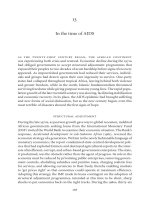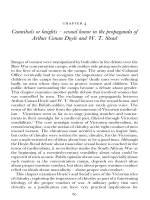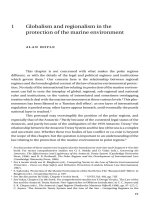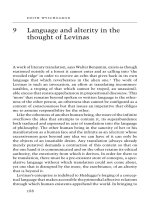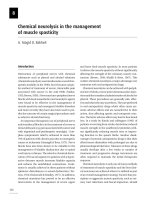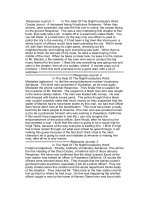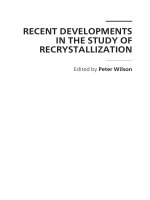Presentations Chapter 6 Some fundamental problems in the study of transfer
Bạn đang xem bản rút gọn của tài liệu. Xem và tải ngay bản đầy đủ của tài liệu tại đây (231.61 KB, 51 trang )
CHAPTER 6: SOME FUNDAMENTAL
PROBLEMS IN THE STUDY OF TRANSFER
Presented by:
Tran Thi Duong
Bui Thi Thanh Hoa
Truong Thi Bich Hong
Bui Thi Hoang Mai
Huynh Ngoc Mai
Nguyen Thi Sinh To
Nguyen Thi Cam Ha
1
CONTENTS
I. Problems of definition
1. Some observations about what transfer is not
2. The definition of substratum transfer
II. Problems of comparison
1. Descriptive and theoretical adequacy
2. Some problems in contrastive descriptions
3. Structural and nonstructural factors
4. Comparison of performances
III. Problems of prediction
1. Forecasts and explanations
2. A classification of outcomes
2
CONTENTS
IV. Problems of generalization
1. Language Universals
2. Linguistics typologies
3. Universalist assumptions
3
What is transfer ?
4
I.
Problems of definition
1. Some observations about what transfer is not
1.1.Transfer is not simply a consequence of habit formation.
-Carroll(1968): the behaviorist notion of transfer is quite different from the
notion of native language influence.
+The behaviorist notion of transfer often implies the extinction of earlier habits.
+The acquisition of a second language need not(and normally does not) lead to any
replacement of the learner’s primary language.
Behaviorism may never have been relevant to the study of transfer. Behaviorism
is now so widely discredited in the field of psycholinguistics that some leading
textbooks in that field give virtually no attention to behaviorist analyses(e.g.,
Clark and Clark 1977; Foss and Hakes 1978).
-Whitney(1881) used the term transfer to refer to cross-linguistic influences- long
before any linguists thought of linking it to the notion of habit formation.
5
I. Problems of definition
1.2 Transfer is not simply interference.
-The notion of interference does seem applicable in the description of
some aspects of second language performance, such as phonetic
inaccuracies that resemble sounds in the learner’s native language.
negative transfer
For example:
Nevertheless, much of the influence of the native language (or of some
other previously learned language) can be very useful, especially
when the differences between two languages are relatively few.
positive transfer
For example: the number of Spanish-English cognates (e.g., público
and public) is far greater than the number of Arabic-English
cognates.native speakers of Spanish have a tremendous advantage
over native speakers of Arabic in the acquisition of English vocabulary.
6
I. Problems of definition
1.3. Transfer is not simply a falling back on the native language
-Krashen (1983): Transfer… can still be regarded as padding, or the result of falling back on
old knowledge, the L1 rule, when new knowledge…is lacking.
-There are several problems with analyzing transfer as merely a falling back:
+First, it ignores the head start that speakers of some languages have in coming to a new
language.
For example: the similarities in vocabulary, writing systems, and other aspects of English and
Spanish reduce the amount that may be utterly new in English for Spanish speakers in
comparison with Arabic speakers.
+Second, Krashen’s statements imply that native language influence is always manifested in
some transparent “L1 rule”. However, native language influences can interact with other
influences so that sometimes there is no neat correspondence between learners’ native
language patterns and their attempts to use the target language.
+Third, transfer may be a mere “production strategy” fails to recognize that cross-linguistic
influences can be beneficial in listening or reading comprehension.
+Fourth, Krashen’s analysis cannot account for the long-term results of language contact in
some settings.
For example: In the case of Ireland, learners of English seem to have fallen back frequently on
knowledge of Irish, but such falling back was never entirely eradicated nor did it halt the
wide-scale adoption of English.
7
I. Problems of definition
1.4. Transfer is not always native language
influence
When individuals know two languages,
knowledge of both may affect their
acquisition of a third.
knowledge of three or more languages can
lead to three or more different kinds of
source language influences.
8
I. Problems of definition
2. The definition of substratum transfer
Transfer is the influence resulting from similarities and differences
between the target language and any other language that has been
previously (and perhaps imperfectly) acquired.
*It is only a working definition, since there are problematic terms within the
definition: influence, acquired.
*A fully adequate definition of transfer seems unattainable without
adequate definitions of many other terms, such as strategy, process,
and simplification. Such definitions may presuppose an account of
bilingualism that accurately characterizes relations between transfer,
over-generalization, simplification, and other second language
behaviors.
*Thus, one might plausibly argue that a fully adequate definition of
transfer presupposes a fully adequate definition of language.
9
II. PROBLEMS OF COMPARISON
Descriptive
and theoretical adequacy
Some problems in contrastive descriptions
Structural and nonstructural factors
Comparison of performances.
10
Descriptive and theoretical adequacy
According to Chomsky (1965), an ideal
grammar would be both descriptively and
theoretically adequate, and the same criteria
apply to contrastive analysis.
Descriptive adequacy is a precondition for
theoretical adequacy.
11
Some problems in contrastive
descriptions
One of the most fundamental problems is
idealization.
Why is idealization a fundamental problem?
Because:
12
Idealization is the characterization of the most
important aspects of a language with the elimination
of unneeded detailed.
Idealisation of linguistic data is unavoidable since
there are many minute variations in the speech of
individuals who consider themselves to be speakers
of the same language.
Some problems in contrastive
descriptions
Too much idealization amounts to distortion.
Another challenge for any contrastive
description is the interaction of linguistic
subsystems.
Psycholinguistic research has demonstrated a
strong interdependence among discourse,
syntax, phonology, and other subsystems in
the comprehension and production of
language.
13
Structural and nonstructural factors
No matter how good a contrastive analysis is, more
than just structural comparisons are necessary for a
thorough understanding of transfer, since native
language influence interacts with nonstructural
factors.
What is structure?
Structure (tagmeme) is a unity of form (some definite
pattern) and function (some definite use).
14
Structural and nonstructural factors
Discourse involves much more than what a
purely structural analysis covers.
One problematic relation between structural
and nonstructural factors is language
distance, or the degree of similarities
between two languages.
15
Comparison of performances
A contrastive analysis is a necessary condition to
establish the likelihood of transfer, but it is not a
sufficient condition.
* transfer interacts with other factors
* explanations based only on contrastive analyses are
sometimes misleading
⇒ Comparisons of performances of two or more groups of
learners with different native languages are necessary.
16
Comparison of performances
Example : I know the man that John gave the book to
him .
( an error made by Persian speakers)
- Contrastive analysis: Persian relative clauses often have
resumptive pronouns ⇒ error
- Comparison of performances : such errors are also
made by speakers of languages not having resumptive
pronouns in equivalent relative clause.
17
Comparison of performances
In some cases the need for a formal
comparison of performances is not very great.
Two kinds of comparison:
* Implicit comparison: Certain spelling errors or
grammatical errors reflect characteristic
problems of speakers of particular native
languages.
E.g. : the spelling of playing as blaying is more
likely to be the spelling error of an Arabic
speaker than of a Spanish speaker.
18
Comparison of performances
Explicit comparison: an error is rather common among
speakers of several different native languages.
E.g. : the omission of articles is common among
speakers of several languages.
( Picture is very dark )
19
* While explicit comparisons are often desirable in
determining negative transfer, they are indispensable
in determining positive transfer.
Comparison of performances
In some cases the need for formal comparison of
performances is not very great.
While formal comparison of spelling and verbs errors
are possible, the distinctiveness of the errors
amounts to an implicit comparison. In this case,
explicit comparisons are preferable.
While explicit comparisons are often desirable in
determining
negative
transfer,
they
are
indispensable in determining positive transfer.
20
Comparison of performances
Some studies suggest that some positive
transfer occurs even when the contrastive
prediction is stated in a very crude way.
Other studies suggest that schooling may
decrease - not increase - the likelihood of
negative transfer.
21
Some fundamental problems in the
study of transfer
Problems of prediction
22
Forecast and explanations
23
The literature on contrastive analysis frequently refers to
predictions that are determined by cross-linguistic
comparisons.
In reality, however, the “predictions” of learners’
behavior are often derived after the fact: What counts as
a prediction is frequently based on data about learner
performances already known to a linguist who has
interpreted the data record with the help of crosslinguistic comparisons. (Wardhaugh 1970)
24
A record of errors in French made by Englishspeaking students in previous year can serve as
a predictor of errors that English-speaking
students will make in a French course next year.
However, such predictions are clearly different
from the kind made before the actual
performance of learners is investigated.
A
good contrastive analysis should
make it easier to explain why
transfer will or will not occur in any
given instance.
25
